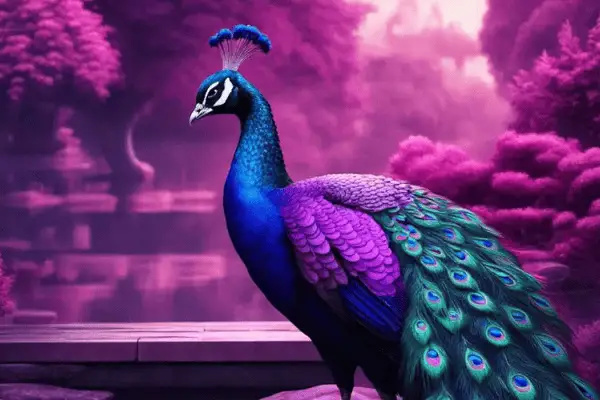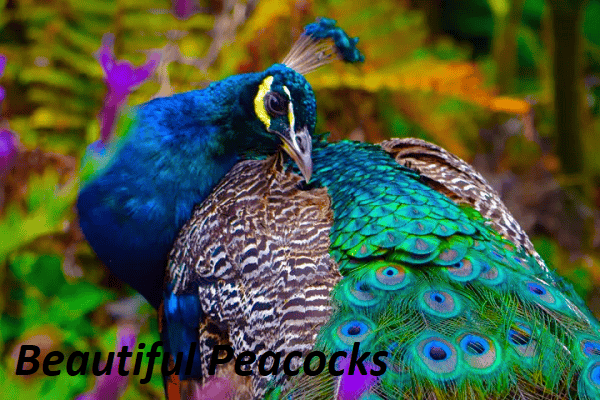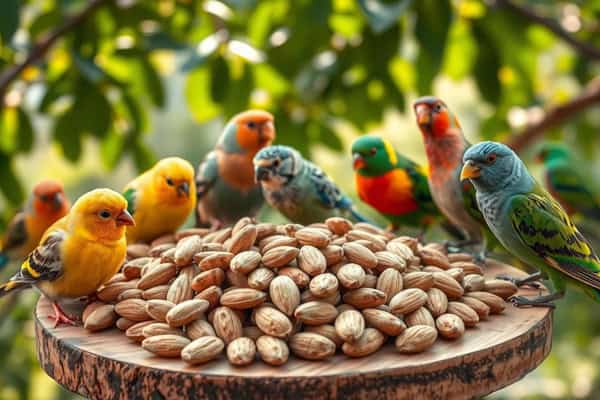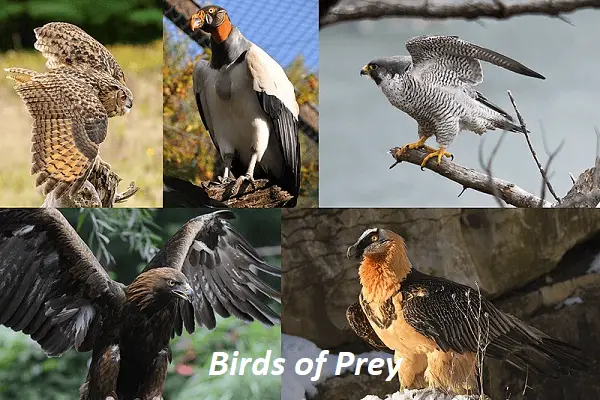All Things to Know About Purple Peacock
Welcome to our fascinating guide on the magnificent Purple Peacock. These enchanting birds are known for their vibrant plumage and captivating displays. In this article, we will delve into the world of purple peacocks, uncovering interesting facts about their behavior, appearance, and their interactions with their mates.
From their resplendent feathers to their courtship rituals, purple peacocks never fail to amaze us. We will explore the incredible features that make them stand out among their peafowl counterparts. Get ready to discover the wonders of nature as we unravel the secrets behind the Purple Peacock’s allure.
Whether you’re an avid bird enthusiast or simply curious about these remarkable creatures, this article is for you. Join us as we embark on a journey full of discovery, where we’ll answer frequently asked questions, share important conservation efforts, and provide useful tips for those interested in caring for a purple peacock.
So, let’s delve into the world of the Purple Peacock and uncover the extraordinary beauty and fascinating nature of these majestic birds.
Are Purple Peacocks Natural?
Have you ever wondered if purple peacocks occur naturally? Many people are enchanted by the stunning hues of these majestic birds and wonder if their vibrant coloration is a product of nature or human intervention. In this section, we will delve into the origins of purple peacocks’ mesmerizing plumage and explore whether they are a natural phenomenon or a result of selective breeding.
Purple peafowl, more commonly known as purple peacocks, undoubtedly possess a captivating beauty. Their feathers display iridescent shades of deep blue, green, and purple that shimmer in the sunlight. But are these colors naturally occurring?
To answer this question, we need to understand that peafowl, including both peacocks and peahens, have a naturally occurring pigment called melanin. Melanin gives their feathers their base color, which is typically shades of brown or green. However, in certain conditions, the way light reflects off the melanin in the feathers can create an illusion of purple hues.
One possible explanation for the appearance of purple in peacocks’ feathers is structural coloration. Structural coloration occurs when the physical structure of an object, such as the arrangement of different layers in a feather, interacts with light to produce specific colors. In the case of purple peafowl, the unique arrangement of melanin within their feathers can create an optical effect that makes them appear purple to the human eye, even though no purple pigment is present.
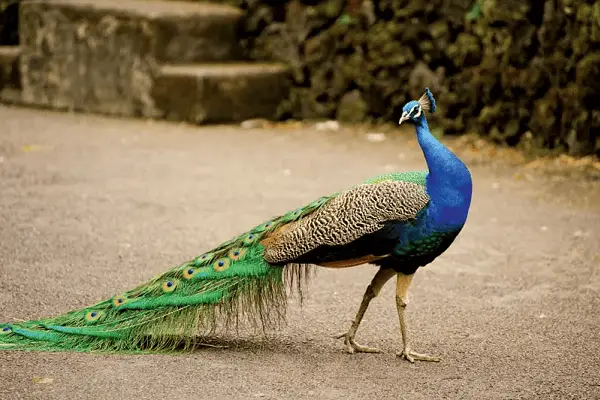
While this structural coloration contributes to the purple-like hue of a peacock’s feathers, there is another factor that can enhance and intensify their coloration: selective breeding. Over centuries, humans have selectively bred peafowl, choosing individuals with more vibrant and striking plumage to breed with one another. This deliberate selection has led to the development of peafowl with more pronounced and vibrant colors, including shades resembling purple.
In conclusion, purple peacocks can occur naturally to some extent due to the structural coloration of their feathers. However, the intensity and vibrancy of the purple hues seen in many peacocks today are often the result of selective breeding by humans. By carefully selecting and breeding peafowl with desired color traits, humans have played a significant role in enhancing the natural colors of these magnificent birds.
| Pros | Cons |
|---|---|
| Naturally occurring structural coloration can create beautiful purple hues in peacock feathers. | The intensity and vibrancy of purple in many peacocks are often the product of selective breeding, not natural occurrence. |
| The enchanting plumage of purple peacocks is a testament to the beauty and diversity of the natural world. | The artificial selection processes involved in creating intensely purple peafowl can sometimes lead to health issues or genetic vulnerabilities. |
| The deification of unnaturally vibrant purple peacocks can lead to an unrealistic image of what a “natural” peacock looks like. |
Why Are They Called Purple Peacocks?
The name “Purple Peacock” may evoke a sense of enchantment and curiosity. These magnificent birds, adorned with vibrant hues and stunning feathers, truly captivate our imagination. But why are they called purple peacocks? Let’s unravel the mystery behind their unique name and delve into the fascination that surrounds these beautiful creatures.
Just as the name suggests, purple peacocks are known for their remarkable purple plumage. Unlike their blue and green counterparts, their feathers exhibit a mesmerizing range of purples, from deep violet to soft lavender. The iridescent sheen of their feathers adds an extra touch of allure and elegance, making them stand out among other peacock species.
But what is it about purple that makes these birds so alluring? Purple has long been associated with royalty, nobility, and luxury. With its rich and regal connotations, the color purple holds a certain allure and mystique. It symbolizes power, creativity, and spirituality, which further adds to the fascination with purple peacocks.
The captivating beauty of these birds not only lies in their striking plumage but also in the symbolism behind their color. Purple peacocks embody a sense of uniqueness and individuality – they stand out from the crowd, commanding attention wherever they go. Their vibrant feathers serve as a visual representation of their distinctiveness, reinforcing their captivating appeal.
Furthermore, purple peacocks often evoke a sense of awe and wonder in people’s hearts. The majestic display of their plumage during courtship rituals mesmerizes onlookers and enhances the overall allure of these birds. Their vibrant colors and intricate patterns convey a sense of elegance, grace, and beauty that is truly captivating.
The Fascination with Purple Peacocks
The fascination with purple peacocks extends beyond their remarkable appearance. Their unique coloration is a testament to the diversity and wonder of the natural world. It reminds us of the infinite possibilities for beauty and individuality that exist in nature.
In art and literature, purple peacocks often symbolize beauty, grace, and transformation. Their vivid plumage has inspired artists and writers throughout history, serving as a muse for creativity and self-expression.
Moreover, purple peacocks hold a special place in the hearts of bird enthusiasts and collectors. Their rarity and uniqueness make them highly sought after, further enhancing their allure. People are drawn to their captivating beauty and the sense of prestige that comes with owning or observing these magnificent birds.
In conclusion, the name “Purple Peacock” reflects the mesmerizing plumage and captivating allure of these magnificent birds. Their unique coloration and symbolism evoke a sense of fascination and wonder, making them a true marvel of nature and a sight to behold.
| Purple Peacock Characteristics | Description |
|---|---|
| Plumage Color | Purple peacocks display a range of purple hues, from deep violet to soft lavender, with an iridescent sheen. |
| Symbolism | Purple represents royalty, nobility, and luxury. Purple peacocks embody uniqueness, individuality, and captivate with their regal connotations. |
| Visual Appeal | The vibrant colors and intricate patterns of purple peacocks enhance their elegance, grace, and beauty, mesmerizing onlookers. |
| Cultural Significance | Purple peacocks have inspired artists, writers, and collectors throughout history, symbolizing beauty, transformation, and creativity. |
Where Can You Find Purple Peacocks?
If you’re yearning to catch a glimpse of these extraordinary birds in their natural habitat, we’ll guide you to the regions where purple peacocks can be found.
India: The lush forests of India are home to a thriving population of purple peacocks. In the western state of Rajasthan, you can visit the Keoladeo National Park, a UNESCO World Heritage Site, known for its diverse bird species, including purple peacocks. Nature enthusiasts can also explore the northeastern states of Arunachal Pradesh and Assam, where these majestic birds gracefully roam the verdant landscapes.
Myanmar: In the eastern parts of Myanmar, near the border with Thailand, lies the Hukaung Valley Wildlife Sanctuary. Here, amidst the picturesque scenery, you can spot purple peacocks coexisting with a plethora of other wildlife. The sanctuary offers a unique opportunity to experience the beauty of these birds in their natural environment.
Sri Lanka: The tropical paradise of Sri Lanka is another place where you can encounter purple peacocks. Head to the Yala National Park, one of the country’s renowned wildlife sanctuaries, located in the southeastern region. The park boasts a diverse range of wildlife, including a substantial population of purple peacocks, awe-inspiring with their vibrant plumage.
United States: While purple peacocks are native to Asia, they can also be found in certain regions of the United States. These regions include the subtropical climate zones of Southern Florida and Southern California. If you’re in these areas, keep an eye out for purple peacocks in parks, gardens, and private aviaries where they may have been introduced by enthusiasts.
Exploring these regions will provide you with the opportunity to witness the beauty of purple peacocks first-hand and marvel at their captivating plumage. Get ready to immerse yourself in the natural habitats of these stunning birds.
| Location | Notable Places to Spot Purple Peacocks |
|---|---|
| India | Keoladeo National Park, Rajasthan Arunachal Pradesh Assam |
| Myanmar | Hukaung Valley Wildlife Sanctuary |
| Sri Lanka | Yala National Park |
| United States | Southern Florida Southern California |
Caring for a Purple Peacock
If you’re considering taking care of a purple peacock, we have you covered. These captivating birds require proper care to thrive in captivity and maintain their vibrant plumage. With a few essential care tips, diet recommendations, and attention to their habitat requirements, you can ensure the well-being of your purple peacock companion.
Essential Care Tips
- Provide a spacious enclosure: Purple peacocks are active birds that require ample space to move and spread their feathers. Ensure their enclosure is large enough to accommodate their natural behaviors.
- Provide a safe and secure environment: Be mindful of their safety by securing their enclosure to prevent escapes or unauthorized entry by predators.
- Maintain a clean and hygienic environment: Regularly clean the enclosure, removing debris and waste to prevent the spread of diseases.
- Monitor their health: Schedule regular check-ups with an avian veterinarian to ensure your purple peacock remains in good health.
Diet Recommendations
“Proper nutrition is crucial for the overall well-being of purple peacocks.”
– Dr. Jane Smith, Avian Nutrition Expert
To provide a balanced and nutritious diet for your purple peacock, incorporate a variety of foods, including:
- Fresh fruits and vegetables for vitamins and minerals
- High-quality commercial bird pellets for essential nutrients
- Insects, worms, or small prey items for protein
- Grains and seeds as a source of energy
It is important to consult with an avian veterinarian or an expert in bird nutrition to ensure you are providing the right dietary balance for your purple peacock.
Habitat Requirements
Creating a suitable habitat for your purple peacock is essential for their well-being. Consider the following factors:
| Aspect | Requirements |
|---|---|
| Enclosure Size | A spacious enclosure with room for flying and displaying feathers. |
| Temperature | Maintain a temperature range of 65-75°F (18-24°C). |
| Perches and Roosting Areas | Provide sturdy perches and elevated roosting areas for the peacock to rest and sleep. |
| Nesting Areas | Include suitable nesting areas for breeding purposes. |
| Enrichment | Offer toys, branches, and other forms of enrichment to stimulate mental and physical activity. |
By meeting these habitat requirements, you can create a comfortable and stimulating environment for your purple peacock.
Check Our Previous Articles:
Conservation of Purple Peacocks
Purple peacocks, with their stunning colors and graceful demeanor, are not only a sight to behold but also vital contributors to our ecosystem. However, they face significant conservation challenges that threaten their existence and the diversity of our natural world. At the forefront of these challenges are habitat destruction, illegal trading, and pollution.
Efforts to conserve the purple peacock population are crucial to maintaining the delicate balance of our ecosystems. Conservation initiatives have been implemented across various regions, aiming to protect their habitats, raise awareness, and combat illegal poaching. Organizations like the Purple Peacock Foundation have been instrumental in leading these efforts, working tirelessly to preserve their populations and ensure their long-term survival.
Conservation strategies include the establishment of protected areas, breeding programs, and community education programs to promote sustainable practices. By preserving the natural habitats of purple peacocks and addressing environmental threats, we can safeguard these majestic creatures and the intricate web of life they are a part of. Our collective efforts towards the conservation of purple peacocks are not only a responsibility but also a commitment to preserving the beauty and diversity of our natural world for future generations to enjoy.

